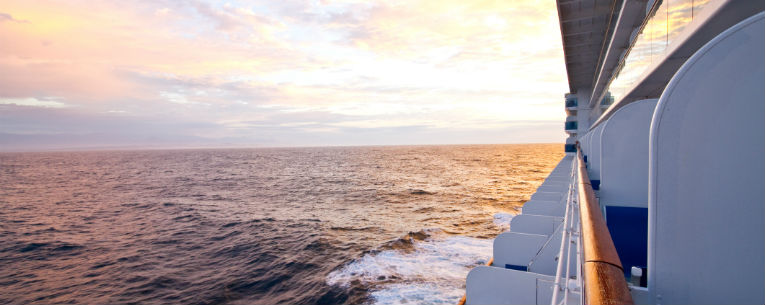You feel a deep sadness every time your ship turns around to head home. If you could live on a cruise ship, like that one lady, you totally would. If only you could afford it…
Here’s an idea: Have you ever considered a repositioning cruise? A repositioning cruise occurs at the end of a cruising season — usually the fall or spring — when a cruise ship is moving from one home port to another.
Many repo cruises are long, crossing the Atlantic or passing through the Panama Canal. It’s a one-way cruise, which means you’ll have to fly home at the end of the trip, but it can be a wonderful way to see new countries and rarely visited ports. As a bonus, you can enjoy Europe without feeling a bit of jet lag.
The main reason cruise aficionados love repositioning cruises is because they’re cheap. Fares may be half the cost of a typical cruise because cruise lines just want to offset the cost of moving the ship from port to port.1 There are less tangible benefits, too. The crew is often beginning their season at sea, so they’ll be refreshed and even friendlier than usual. And if your idea of heaven is a gleaming, pristine ship, you may be able to find a repositioning cruise in which a brand-new vessel is making the journey from the shipyard to its home port.
Tips for going on a repositioning cruise
Don’t make it your first-ever cruise. You shouldn’t commit to two weeks aboard a ship unless you already know you enjoy the cruising lifestyle. For a transatlantic repositioning cruise, you could be at sea for seven days or more.
Know the ship. Make sure you’re compatible with the amenities, the food and the general vibe of the ship. Larger ships may have more options for onboard entertainment, which is useful for those long sea days. Smaller ships may schedule special guest lecturers or enrichment programs.
Don’t book too early. Because repositioning cruises aren’t a good fit for every traveler, cruise lines sometimes have a hard time filling cabins. That means you can sometimes find last-minute deals for as little as $40 per night for an inside cabin, Cruise Critic reports.2
Choose your cabin carefully. That $40 per night cabin sounds appealing, but do you want to be in a windowless room for two weeks? Conversely, you may not want to spend extra money for a balcony cabin if you’re crossing the north Atlantic in April (unless you find forty-degree gales refreshing). Make sure your cabin is a place you’ll feel at home.
Maintain a fitness routine. Two weeks at sea plus rich, delicious dinners means you may finish your cruise carrying a few extra pounds. Plan to hit the gym or walk a few miles on the deck each day. Too much salty food can result in swollen feet and bloating — if this is a problem for you, the Cruise Maven suggests requesting a sodium-free diet for the cruise.3
Watch your budget. When it’s day five at sea, without a speck on the horizon, you may be tempted to hit the casino or splurge on a spa treatment. That’s exactly what the cruise line hopes you’ll do! Repositioning cruises are a better fit for frugal travelers who can entertain themselves by reading, writing, chatting or crafting.
Don’t forget insurance! Travel insurance is a must for any overseas journey, but it’s especially important for cruises. If you must cancel your cruise last minute for a covered reason; if your luggage goes missing before you set sail across the Atlantic; or if you experience a covered medical emergency while at sea, travel insurance can save the day. Get a quote now.
Repositioning cruise destinations
So where can you go on a repositioning cruise? All over the globe! Here are some examples of common repositioning routes, although itineraries and ports vary by cruise line and season.
- Santiago to Los Angeles: This 16-night cruise visits ports in Chile, Peru, Costa Rica, Nicaragua, and Mexico, giving you a taste of several Latin American cities.
- Tampa to Barcelona: Many ships relocate from the Caribbean to the Mediterranean in spring (and back again in fall). The two-week journey typically includes a full week at sea, but you also get to visit the gorgeous Canary Islands and Malaga, in Spain.
- Rome to Dubai: This 16-night cruise in late fall visits some of the most scenic ports in the Mediterranean — Sicily, Athens, and Santorini — before passing through the Suez Canal into the Red Sea. Then, see Aqaba, Jordan, and Muscat, Oman, before arriving in Dubai.
- Miami to San Francisco: There are two big bonuses to repositioning cruises that pass through the Panama Canal. One, you visit lots of ports, such as Havana, Cartagena, Acapulco and Cabo San Lucas. Two, you only have to buy domestic airfare.
- Bergen to Montreal: Viking Ocean Cruises has introduced a special repo cruise called “In the Wake of the Vikings,” which follows explorer Leif Eriksson’s route from Bergen in Norway over the North Atlantic to Canada. This 15-day cruise isn’t cheap but promises rare opportunities to visit the Shetland and Faroe Islands, Greenland, Iceland, and Newfoundland.
- Montreal to Miami: This fall repositioning cruise lets you take in the sights of the entire east coast. Experience Bar Harbor’s rugged beauty, New England’s glorious fall foliage, a night in New York City, the Southern charms of Charleston and then the warmth of Florida beaches.
- Tokyo to Vancouver, B.C.: Transpacific repositioning cruises move ships from Asia to Alaska each spring. One Holland America itinerary visits the cities of Yokohama, Hakodate, and Kushiro, as well as two Alaskan ports, before arriving in Vancouver.4
- Seattle to Sydney: The queen of repositioning cruises may be this 18- to 21-night journey across the Pacific. The ship visits Hawaii as well as Polynesian islands such as Fiji, Tahiti, Bora Bora, Vanuatu and New Caledonia before arriving in Sydney. Just don’t forget to ask someone to water the plants while you’re gone.
Related Articles








Share this Page